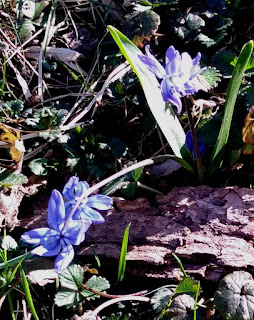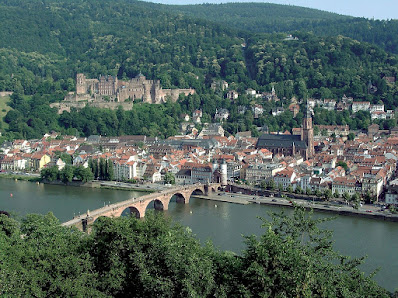It is, or can be, difficult to get masses of men to slaughter each other. Many of us have a strong reluctance to take other human lives. To help men overcome this reluctance, warrior societies have come up with many strategies, some of them involving training or symbols like uniforms, others essentially psychological. These days we talk often about how people dehumanize their enemies, thinking of them as less than human, and we can document such degradation of enemies back to the beginning of history. But there is another ancient strategy for getting men to kill without compunction, and that is persuading them to dehumanize themselves.
Beast warriors are known around the world: Aztec eagle warriors, African leopard and lion men, Cheyenne wolf soldiers. These were men, often elite professional soldiers, who took on the role of predators, pushing humanity from their minds by assimilating themselves to powerful, deadly animals. The Iron Age Norse had two kinds of beast warriors: Berserkir or "Bear Shirts" and Úlfhéðnar or "Wolf Coats." These are not figments of modern romantic imagining, but are actually among the best-documented parts of Viking Age culture. They are attested in dozens of surviving texts, from the oldest fragments of Viking poetry to the last romances composed on 15th-century Iceland. It was not rare for warriors to be buried wrapped in or lying on bear skins, which archaeologists can tell because they left the paws of the bear attached, with their bones and claws.
But after acknowledging their existence we have pretty much exhausted what historians agree on about Viking beast men; there is no statement you can make about them that someone will not dispute. What were they for? How were they chosen? What was it like to be one? These are all hard questions, but I think there are plausible answers.
The oldest extended description of Viking beast men comes from a 9th-century poem called Haraldskvæði, describing the army of Harald Fair-Hair:
I'll ask of the berserks, you tasters of blood,
Those intrepid heroes, how are they treated,
Those who wade out into battle?
Wolf-skinned they are called. In battle
They bear bloody shields.
Red with blood are their spears when they come to fight.
They form a closed group.
The prince in his wisdom puts trust in such men
Who hack through enemy shields.
This passage introduces one of the important themes about these men, that they were associated with kings. It was only the greatest lords who could keep troops of such men, perhaps because they were not much use for anything but fighting. They formed a key element of royal armies. And they came in troops; usually this was something men did collectively, not individually.
Notice that the Haraldskvæði more or less lumps the bear shirts and the wolf coats together. Other texts suggest that they fought quite differently. In one interpretation of these texts, Úlfhéðnar were lightly armed troops who carried javelins and fought as skirmishers – like Roman velites, who also sometimes wore wolf skins. Berserkir were by contrast heavily armed and fought as shock troops, used to man the prows of warships and to break enemy shield walls. That makes sense, but I think it is not well-documented; most Norse authors seem to have considered wolf and bear men to be essentially the same thing. The later sources, especially the late medieval "romances" from Iceland, take a negative view of the beast men, who appear as stock villains. But there is no evidence of this in the early texts, so it may be a Christian prejudice.
Both
Berserkir and
Úlfhéðnar were specially devoted to Odin. Indeed in poetry they were often simply called "Odin's men." To become a beast man was for the Vikings a religious vocation. It seems likely that you became one by swearing a solemn vow to Odin, and thus that men chose this status themselves. Most warriors were not beast men, even in royal retinues, so it does not seem that anyone was required to join. It may be relevant here that Norse kings were also specially devoted to Odin, a god of kings among many other roles, and that kingship was in part a religious office.
The most distinctive thing about these men was of course their battle fury. Battle madness is a phenomenon known around the world, and we have hundreds of detailed descriptions from every continent. One interesting point is that in this state of fury many men have seen the world tinged with red, and there are possible physiological explanations. Norse poets also used this device; when they spoke of "reddened spears" they often did not mean the red of blood, but the red that tinged the whole world when the fury took you. The Norse word for this was berserkergang, quite literally to "go berserk." Most of our descriptions of battle fury give it a random quality, something that fell suddenly on certain men in particular circumstances, for example when a friend or their lord was killed. The remarkable thing about the Norse beast men was that they cultivated the ability to do this whenever called upon. They were not just subject to battle fury, but made a profession of it.

How did they do that?
According to our sources, they: howled; shouted; chewed on hot coals; ran through raging fires; bit their shields; danced violently; brandished their weapons; beat their swords or spears on their shields; practiced horrible grimaces and frightening postures; and filled themselves with rage. Since a bag of henbane seeds was found in the grave of the Sorceress of Fyrkat, people had considered that chewing those seeds might have been part of berserkergang. (That's what they do in The Vikings.)
These are techniques adopted from shamanism. More or less, beast men achieved battle fury using the same techniques shamans used to enter trance states: drugs, violent movements, pain, shouting, rhythmic noise, hyperventilation. But the key to shamanic trance is none of these things. It is an internal training of the mind, and there are shamans who can enter trance states pretty much at will and only go through the routine of dancing and drumming because the audience expects it. You get better at it with practice, which is why shamanism is a profession. (This ability is almost certainly bad for your overall mental health, which is why shamans are generally considered crazy.) Norse beast men did not "go berserk by chewing on their shields," but by devoting themselves to the pursuit of trance states for years and decades.

Shamanism makes sense only if you believe the world is full of spirits, whose acts often determine human fate. This is another way that the Norse beast men were shamanistic, since the Vikings believed the battlefield was a spirit realm. They thought Odin stalked every battleground. With him came a horde of the battle spirits we call Valkyries, flying female goddesses of killing and death. Norse poetry about battle consists in large part of one kenning after another based on the names of the 30-odd famous Valkyries: Skuld's banquet, Skogul's clamor, Gunnr's lawcourt; Gondul's weaving; without a list of these names handy you can hardly read Norse war poetry. The Valkyries did not just choose dying warriors to lead to Valhalla, but participated in the fight. They sharpened some weapons and blunted others, blinded some men while giving others keen sight, guided spears and arrows to their targets or whisked them away. It was their actions, and behind them the will of Odin, that determined victory or defeat. The bear shirts and the wolf coats, dedicated to Odin, were on special terms with the Valkyries, who led them into their battle fury. Of course that did not mean the Valkyries would necessarily help them win, since Odin was an unreliable patron who might decide to grant victory or might instead decide that he needed all these men in Valhalla right now.
As I said, most Norse warriors did not become beast men. Yet I still think this phenomenon sheds some light on the enduring mystery of the Viking expansion. The Vikings were, when you think about it, almost insanely brave. They sailed far beyond the limits of profit or good sense, made war on kingdoms with far more men and money, sacrificed their lives in crazy expeditions with little chance of success. We used to think that they settled widely, leaving descendants across Europe, but recent genetic studies have found little trace of them in Britain, Ireland, or Russia. Except on a few islands they were a small minority everywhere they went, dominating for a brief time by sheer ferocity.
The Vikings did this, it seems, because they made a religion of violence and devoted their lives to it.
That was of course not all of the Norse world, which was much about raising sheep and babies, or trading salt fish for wine. But their cult of killing and death was what made the Vikings such a phenomenon.
They left their homes and families, separating themselves from everything that might have softened their fury. Once across the dangerous sea they entered a world where devotion to Odin was everything, where every man's or woman's fate was already fixed by the gods, where the best they could hope for was to die so gloriously that songs of their ends might be sung and remembered. It was in war, and only there, that they transcended the limits of the normal human world. In battle they could cross the boundary of reality and experience something more, something beyond what anyone who stayed home with the cows could ever know, something that justified earthly existence and opened the doors of Asgard. They floated to heaven on a tide of blood, half that of their enemies, and half their own.





















































